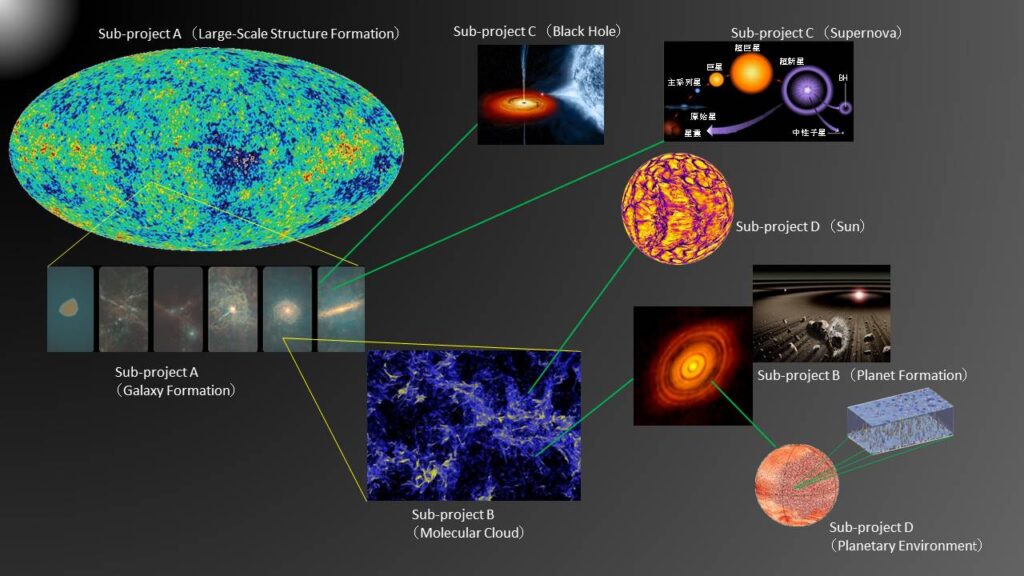Objective
Objective
The objective of this project is to build an overall and unified understanding of the formation and evolution of hierarchical structures in the universe, from the Big Bang, the beginning of the universe, to the formation of structures due to gravitational instability in the expanding universe (formation of the dark matter halo), associated galaxy formation, star formation within galaxies, planet formation associated with star formation, evolution of planets after formation, formation of surface environments, and solar activity and its effects on the heliosphere and the Earth, by combining multi-scale simulations and the latest observations.
In this project, we will construct models with sufficient resolution and appropriate physical processes that can be directly compared with observations at each level, and compare them with observations to achieve an interconnected understanding of the hierarchy.
Specifically, we have set up the following 4 Sub-project. In each of these sub-projects, as summarized in the following table, we will conduct simulations that greatly exceed the current world level, which will not only dramatically advance research in each area, but will also enable us to understand the interaction between hierarchies, such as galaxy formation and star cluster formation, and star cluster formation and star formation.
- Sub-project A: Revealing the Formation History of the Universe with Large-scale Simulations and Astronomical Big Data
- Sub-project B: From Clouds to Stars and Planets: Toward a Unified Formation Scenario
- Sub-project C: High-energy Astrophysical Phenomena in Black Holes and Supernovae
- Sub-project D: Elucidation of Solar and Planetary Dynamics and Evolution
| Sub-issueproject A: Revealing the Formation History of the Universe with Large-scale Simulations and Astronomical Big Data |
|
|---|---|
| Formation of luminous objects in the universe starting from density fluctuations of dark matter | Reproducing the hierarchical structure formation history on the whole scale of the universe starting from the first stars, and generating and publishing big mock observational catalogs. |
| Dynamical effects of neutrinos on large-scale structure formation | Simulation of large-scale structure formation in the universe using direct integration of the collisionless Boltzmann equation to account for cosmological neutrinos. |
| Galaxy formation simulations with stellar scale resolution | Formation of Milky Way galaxy explored by star-by-star galaxy simulation with 1000 times larger number of particles than before. |
| Formation of compact binary stars in dense star clusters | Simulation of a globular cluster using gravitational N-body simulations that reproduce individual stars. |
| Sub-project B: From Clouds to Stars and Planets: Toward a Unified Formation Scenario |
|
|---|---|
| Formation of molecular clouds and molecular cloud cores in galaxies | Molecular cloud core formation simulations in the galactic disk that consistently reproduce multi-scale physical phenomena with a spatial resolution more than an order of magnitude higher than the current state-of-the-art simulations. |
| Global magnetohydrodynamic simulation of protoplanetary disks with solid particles | Global high-resolution non-ideal magnetohydrodynamic simulation of a protoplanetary disk that consistently considers both dust particles and non-ideal magnetohydrodynamic effects. |
| Accumulation of microplanets and planet formation in protoplanetary disks | Reproduction of the formation process of the solar system by calculating the planet accumulation with overwhelming resolution of 1000 times larger number of particles than before. |
| Dust growth in turbulence of protoplanetary disks | Large-scale numerical simulation of turbulent flows solving the Navier-Stokes equations, which will revolutionize our understanding of the initial growth of planetesimals. |
| Sub-project C: High-energy Astrophysical Phenomena in Black Holes and Supernovae |
|
|---|---|
| Black Holes, Accretion Disks, and Relativistic Jets | Relativistic radiation magnetohydrodynamic simulations of black hole accretion disks with a spatial resolution 100 times higher than the current state-of-the-art simulations. |
| First-principles calculation of gravitationally collapsing supernova explosion | Simulation of a gravitationally collapsing supernova explosion by first-principles calculation of neutrino radiation hydrodynamics in three-dimensional space. |
| Sub-project D: Elucidation of Solar and Planetary Dynamics and Evolution |
|
|---|---|
| Solar activity cycle calculation and solar surface sunspot formation calculation | First-principles simulation of solar activity that includes the entire solar convection layer at the world’s highest resolution, 64 times higher than before. |
| Rocky planetary interiors | 3-D simulation of mantle convection with plate tectonics that accurately incorporates magma and mantle dynamics |
| Rocky planet surface atmosphere | Global simulation of planetary atmospheres with 30 times the spatial resolution of the state-of-the-art, fully reproducing the cloud structure observed by spacecraft. |
| Gas planet atmosphere | Numerical simulation of convection in gaseous planetary atmospheres using high-resolution long-time integration based on global calculations. |
Implementation period: April 2020 to March 2023
Representative organizaions: Kobe University
R&D Head: Junichiro Makino (Professor, Graduate School of Science, Kobe University)

